In the Mouth of Madness on Blu-ray and Other Reasons to Go Stark Raving Mad
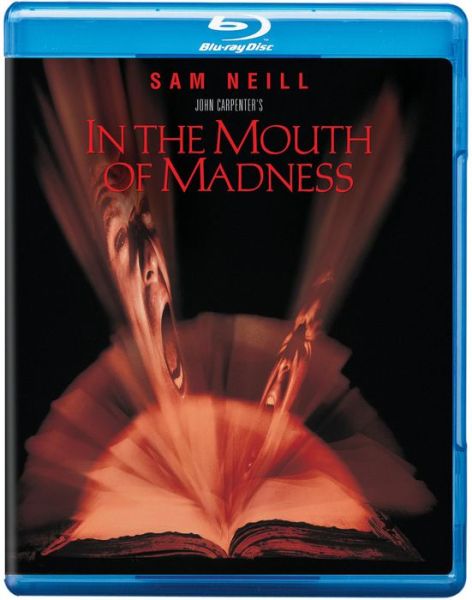 “Believe me, the sooner we’re off the planet, the better.”
“Believe me, the sooner we’re off the planet, the better.”
— John Trent (Sam Neill) in In the Mouth of Madness
John Carpenter is a master filmmaker, one of the most influential genre directors to emerge from the cloudburst of creativity of the 1970s. You’d be hard-pressed to find a science-fiction or horror fan who doesn’t have one of Carpenter’s movies in his or her list of Top [Fill in Number] Films list.
But Carpenter’s popularity has created the illusion that his films achieved greater financial success when first released than they did. The unfortunate truth is Carpenter has had only a few outright hits: Escape from New York, Assault on Precinct 13, and Halloween are the most notable. Halloween throws off the curve: Carpenter’s third feature, it grossed $65 million during its initial domestic run against a budget of $325,000 — and it continues to generate revenue to this day. Halloween also influenced genre movies immediately, igniting the massive “slasher boom.”
But many of Carpenter’s finest and most beloved movies did middling-to-flop business when they premiered. The Thing, rightfully considered his masterpiece, was a financial disappointment for Universal in the summer of 1982. Big Trouble in Little China was an outright box-office disaster. And through the ‘90s, Carpenter could not catch a break with anything. After 2001’s Ghosts of Mars did a spectacular belly flop (a worldwide — yes, worldwide — gross of $14 million against a $28 million budget), Carpenter went into semi-retirement to play video games and watch the Lakers. He has only returned to directing for two episodes of Masters of Horror on Showtime and the barely released and very uninteresting feature The Ward in 2011.
However, the march of appreciation for his movies in their post-premiere years continues. I believe we can now safely deposit one of his 1990s movies in the vault of John Carpenter Classics: In the Mouth of Madness, which debuted on Blu-ray last week. [Update 2018: Now we have a special edition Blu-ray from Shout! Factory.] Carpenter fans have often dubbed it the director’s last great movie, and although I hope that’s incorrect and he still has a surprise waiting for us, the title seems apt. I certainly haven’t seen anything Carpenter has done since that remotely approaches it in quality.
In the Mouth of Madness concludes the “Apocalypse Trilogy,” Carpenter’s name for his trio of films about the potential annihilation of the human race. First came The Thing (on Blu-ray from Universal Home Video since 2008), then Prince of Darkness (recently given a superb Blu-ray treatment by Shout! Factory that I looked at last week). Now Warner Bros., which owns New Line’s catalog, delivers the hi-def disc of the most surreal and unusual of the trilogy. Warner’s disc has almost no extras, aside from a lethally boring commentary from Carpenter and photographer Gary Kibbe recorded for the Laserdisc in 1995. However, the transfer is solid, the sound quality first-rate, and the movie only gets better with each viewing, so this disc is a must-have for fans of Carpenter and H. P. Lovecraft, the uncredited source for much of the movie’s style and themes. The early ‘90s was such a wasteland for horror films that In the Mouth of Madness stands like a colossus, or Great Cthulhu himself.
In the Mouth of Madness differs from its eschatological pair of siblings in three important ways.
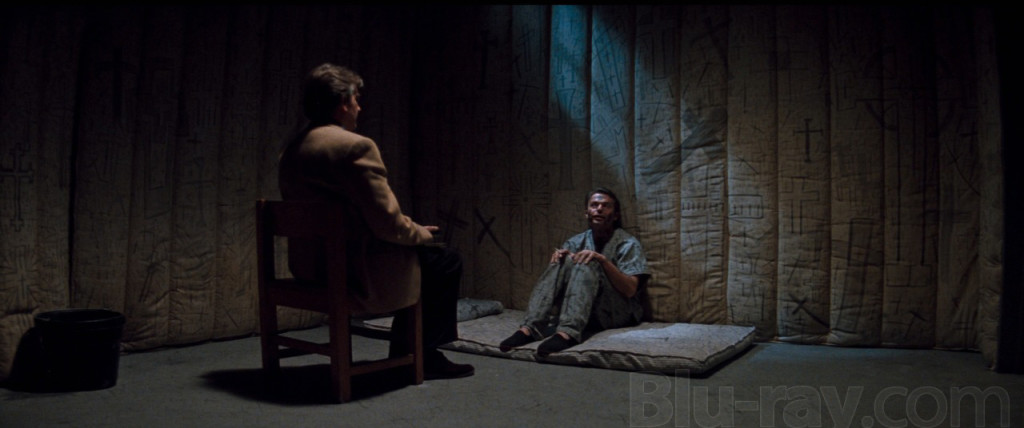 First, where The Thing and Prince of Darkness use ensemble casts, In the Mouth of Madness has a single dominant protagonist who appears in almost every scene. This is Sam Neill’s movie; except for Julie Carmen, the other credited actors in the opening titles only show up in a few sequences each. Carpenter regular Peter Jason (also in Prince of Darkness) is around for a single scene, and high-billed Bernie Casey and David Warner have only two scenes each. Specially credited Charlton Heston (“And CHARLTON HESTON as Jackson Harglow”) has approximately five to six minutes of screen time, probably all shot in one day.
First, where The Thing and Prince of Darkness use ensemble casts, In the Mouth of Madness has a single dominant protagonist who appears in almost every scene. This is Sam Neill’s movie; except for Julie Carmen, the other credited actors in the opening titles only show up in a few sequences each. Carpenter regular Peter Jason (also in Prince of Darkness) is around for a single scene, and high-billed Bernie Casey and David Warner have only two scenes each. Specially credited Charlton Heston (“And CHARLTON HESTON as Jackson Harglow”) has approximately five to six minutes of screen time, probably all shot in one day.
(Spotting bonus: A young Hayden Christensen, the future Anakin Skywalker, appears as the paperboy who directs Trent back to the highway.)
Second, The Thing and Prince of Darkness are “siege movies,” a narrative type that Carpenter loves and which he first used in Assault on Precinct 13, although Dark Star also has elements of it. These stories center on characters trapped in a single location in a struggle to survive against an invading force. In the Mouth of Madness covers larger geographic territory. It’s a “journey movie” for its main character, insurance investigator John Trent: a journey from misanthropic sanity to … extreme misanthropic sanity, a kind of desperate, urgent super-sanity.
The third difference I can’t tell you at the moment. I’ll have to place it behind a “Here Be Details about Ye Ending” barrier later on. But it’s the key variation and one of the superlative aspects of In the Mouth of Madness.
John Trent (Sam Neill, whom Carpenter met while directing Memoirs of an Invisible Man) starts the movie presenting the illusion that he has lost his mind. Dragged into a massive asylum, Trent finds himself interred among the growing number of people suffering from a rapidly spreading form of violent schizophrenia. Trent isn’t suffering from the illness, but after he gauges how bad things are turning on the outside, he goes to great lengths to disguise his sanity so he can remain in the shelter of the asylum.
This opening sequence miscues the film a touch: it’s a bit goofy, with John Glover playing the loopy sanitarium head too broadly, and comic touches like a joke about the music of the Carpenters. (Which, I now realize, is Carpenter making fun of himself. “Not the Carpenters too!” Trent moans.) But then brilliant British actor David Warner arrives at Trent’s padded cell, playing a representative from a government agency investigating what we learn is escalating into a global mental health pandemic. The film’s tone solidifies as Trent begins to tell his story in classic film noir flashback fashion. Looking over these opening scenes after watching the whole movie reveals that the miscues are intentional. Glover’s performance choice makes complete sense at the end of the film. Even the song selection from the Carpenters’ catalogue, “We’ve Only Just Begun,” is dead-on.
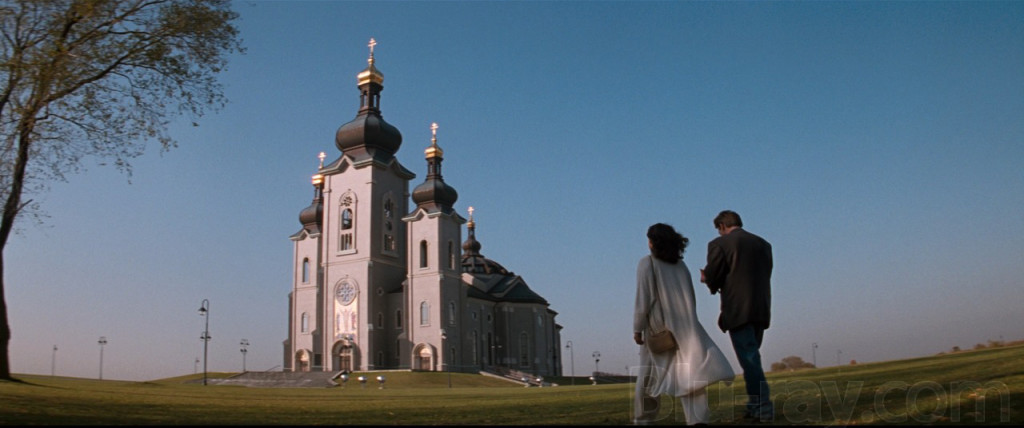 This is a good spot to mention the film’s score, since the main title music forms part of this initial deception. Carpenter composed the soundtrack in collaboration with Jeff Lang, an Australian guitarist. The music that plays under the main titles is a piece that rocks hard with Carpenter’s characteristic synth sounds and Lang’s heavy guitar riffs. But what the hell is this doing over the credits for a moody H. P. Lovecraft-influenced film, much of which takes place in a quaint New England town? It feels wrong in every way. But, ah ha! The score isn’t what you expect. It becomes as strange and ambient as it should when the film ventures into surreal horror. And when that rocking number appears again over the end credits, it fits. This is the madness! Rock out with the Old Ones! (It’s a terrific piece on its own. Unfortunately, In the Mouth of Madness remains one of the only John Carpenter soundtracks currently unavailable on iTunes.)
This is a good spot to mention the film’s score, since the main title music forms part of this initial deception. Carpenter composed the soundtrack in collaboration with Jeff Lang, an Australian guitarist. The music that plays under the main titles is a piece that rocks hard with Carpenter’s characteristic synth sounds and Lang’s heavy guitar riffs. But what the hell is this doing over the credits for a moody H. P. Lovecraft-influenced film, much of which takes place in a quaint New England town? It feels wrong in every way. But, ah ha! The score isn’t what you expect. It becomes as strange and ambient as it should when the film ventures into surreal horror. And when that rocking number appears again over the end credits, it fits. This is the madness! Rock out with the Old Ones! (It’s a terrific piece on its own. Unfortunately, In the Mouth of Madness remains one of the only John Carpenter soundtracks currently unavailable on iTunes.)
Back to our story, which unveils as a combination of Stephen King, H. P. Lovecraft, and the reality-bending playwright Luigi Pirandello. Horror novelist Sutter Cane (Jürgen Prochnow), the most popular writer on the planet, has abruptly vanished, along with the manuscript of his latest book, In the Mouth of Madness. Imagine H. P. Lovecraft with the sales figures of Stephen King: that’s Sutter Cane. Actually, Cane outsells King, as his editor explains. If J. K. Rowling were already publishing in 1995, Cane would outsell her as well. “More people believe in my work than the Bible,” Cane boasts later — in a church confessional, appropriately enough.
Cane’s publishing house, Arcane, files an insurance claim over their multi-million dollar breadwinner’s disappearance. The situation has started to become tense, since the deadline for the book’s publication is approaching and Cane’s fans have started to develop vandalistic streaks. Cane’s agent receives the opening chapters and then promptly goes nuts with an axe in the middle of Manhattan before the police gun him down.
Enter our, uhm, hero, freelance insurance investigator John Trent. Trent lives in a noir world out of Double Indemnity where he breaks down people who commit insurance fraud. The movie re-introduces Trent in a nice sequence where he cracks apart Peter Jason with methodic cruelty. While chain-smoking. Trent smokes a lot.
The insurance company that covers Arcane Publishing sends Trent to see if Cane’s vanishing is a stunt or not. Trent has no interest in the hoo-hah around Sutter Cane, although he does take the time to read through the author’s books. He then makes a discovery from piecing together parts of the book covers: Sutter Cane has gone to hide in the tiny New Hampshire town of Hobb’s End. The problem… Hobb’s End doesn’t exist. It’s a fictional location from Sutter Cane’s novels.
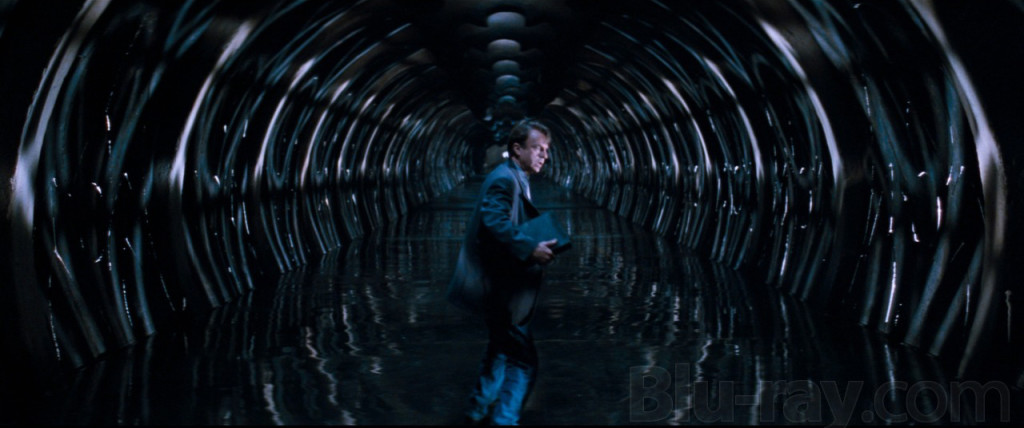 Trent decides to go looking for it anyway, still believing the entire affair is the publishing house pulling a promotional gag. Cane’s editor, Linda Styles (Julie Carmen), accompanies Trent on the road trip. Of course, they find Hobb’s End. And it turns out that either Cane’s work was based on a hidden reality or Cane has managed to change reality through his writing. Whatever the case, it appears that the cosmic Old Ones need Cane’s work to burst into our world and do the whole gibbering madness number on humanity, à la Lovecraft, Cthulhu, Yog Sogoth, et al.
Trent decides to go looking for it anyway, still believing the entire affair is the publishing house pulling a promotional gag. Cane’s editor, Linda Styles (Julie Carmen), accompanies Trent on the road trip. Of course, they find Hobb’s End. And it turns out that either Cane’s work was based on a hidden reality or Cane has managed to change reality through his writing. Whatever the case, it appears that the cosmic Old Ones need Cane’s work to burst into our world and do the whole gibbering madness number on humanity, à la Lovecraft, Cthulhu, Yog Sogoth, et al.
The Old Man of Providence has his fingerprints all over In the Mouth of Madness: books that drive people mad, fictional New England towns harboring horrors, a strange church that once housed a Starry Wisdom-esque cult, tentacled cosmic monstrosities, and a hotel called “Pickman’s.” But as much fun as the Lovecraft material offers — and the brief appearance of the Old Ones in their sanity-blasting glory is immensely satisfying — I think it’s something of a red herring from the reality-twisting and meta-fictional aspects of the movie, the surreal touches that feel like Carpenter referencing Nicolas Roeg’s Don’t Look Now. The fabric of reality is at threat and that pack of cosmic monsters pounding on the threshold might be nothing more than another tool in the box of a writer who has transformed into a god and made reality, fiction, sanity, and insanity fluid states without barriers.
Nor does Lovecraft have the sole horror maven role: Stephen King wields a huge influence, with Hobb’s End sharing as much of King’s Castle Rock, ME as it does Lovecraft’s Arkham, MA. Horror expert Brian Collins and screenwriter Todd Farmer made the astute observation in their loving discussion of the film that In the Mouth of Madness starts with King and ends with Lovecraft.
Sam Neill is superb as the lead, and the forgettable experience of Memoirs of an Invisible Man was worth it if it meant Carpenter got to meet the actor and pick him to star in his next movie. At the time, most people knew the performer from his role in Jurassic Park as the grumpy paleontologist who learns to like kids, but Neill has an impressive and deep filmography, and he turns on the flinty nastiness here like he’s revisiting the character of Damien the Antichrist in The Final Conflict. (Neill and composer Jerry Goldsmith are the only reasons to watch that film.) Neill shines in every scene and it’s a shame that the actor and director haven’t worked together since. He could’ve become Carpenter’s other Kurt Russell.
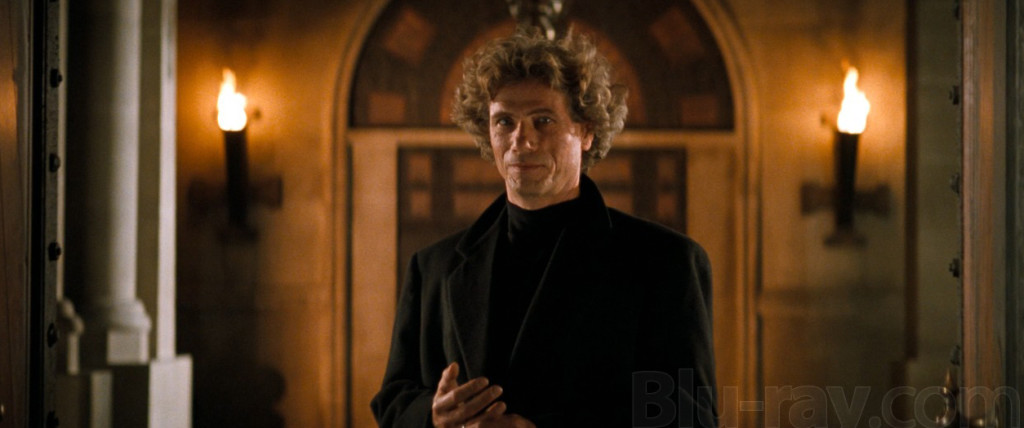 John Trent is an odd protagonist for a Lovecraftian tale. No tweed-armored antiquarian, he’s a chain-smoking, granite-jawed fellow whose job is breaking people apart. He has the lowest opinion of humanity, but this doesn’t make him morose; he enjoys his job, benefiting from the worst aspects of the human race. “Learn to expect the worst in people and you get it. Everyone’s looking to play an angle. I’m always there to clean up the mess.”
John Trent is an odd protagonist for a Lovecraftian tale. No tweed-armored antiquarian, he’s a chain-smoking, granite-jawed fellow whose job is breaking people apart. He has the lowest opinion of humanity, but this doesn’t make him morose; he enjoys his job, benefiting from the worst aspects of the human race. “Learn to expect the worst in people and you get it. Everyone’s looking to play an angle. I’m always there to clean up the mess.”
However, we don’t watch Trent make a journey toward becoming a better man. We instead watch him react to the world turning into a hell he couldn’t have imagined.
The movie’s central conflict is covered in a conversation between Trent and Styles during their drive toward Hobb’s End. Styles confesses that Sutter Cane’s work legitimately scares her, and Trent scoffs:
“What’s to be scared about? It’s not like it’s real or anything.”
“Well, it’s not real from your point of view, and right now reality shares your point of view. What scares me about Cane’s work is what might happen if reality shared his point of view.”
“Whoa, we’re not talking about reality here. We’re talking about fiction. It’s different.”
“Reality is just what we tell each other it is. Sane and insane could easily switch places. If the insane were to become the majority, you would find yourself locked in a padded cell, wondering what happened to the world.”
Viewers already know from the opening scenes that Trent will indeed end up in a padded cell, with the insane on the rise toward the majority. Reality will eventually cease to share Trent’s POV, but that doesn’t make him go crazy. It’s Styles who becomes the conduit into the madness Sutter Cane’s work can cause. Soon after arriving in Hobb’s End, Styles feels her mind start to splinter. She witnesses events she interprets through the lens of Sutter Cane’s fiction, but which Trent instead sees as part of an elaborate hoax. Eventually, Styles cannot handle it — but the irony is that Trent can. He develops a kind of ultra-sanity that accepts that everything bizarre he sees occurring is real. He then becomes the unwilling messenger for Sutter Cane to deliver the madness of the Old Ones to the world and open a portal through the author’s ultimate testament, the novel In the Mouth of Madness. Which is also, in a great meta-turnaround, adapted into the very film you’re watching.
This brings me to the third difference between In the Mouth of Madness and its apocalypse predecessors. If you’ve gotten this far, you probably don’t care much about “spoilers” (and I don’t think this is a “spoilable” film, since the prologue lays out what will happen), but here’s the warning anyway. Proceed with caution.
In The Thing, we don’t know if the world will come to an end, but hope exists that it won’t. The alien creature appears defeated and even if the thing is actually one of the two survivors at the conclusion, it still might freeze and never be found.
In Prince of Darkness, the end of the world is averted — but only temporarily. The final dream sequence and last shot indicates that the anti-god will find another way through to our dimension.
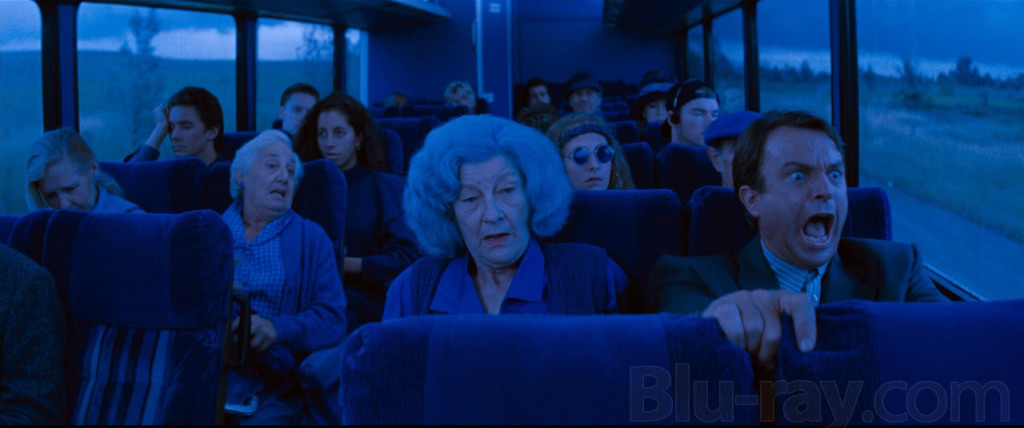 But in In the Mouth of Madness, there’s no ambivalence. John Carpenter finally brings an end to the human race. John Trent wanders from the ruined asylum into a destroyed world, with only a few people left on short-wave radios shouting for help as madness overruns the entire planet. Victims have even started to take on the shapes of the Old Ones. Trent stumbles through the desolation, finds an empty cinema playing In the Mouth of Madness (the poster has identical credits to the actual movie, except for the actors), and sits down to watch himself. The film concludes with Trent laughing crazily at the screen, enjoying a movie about the world’s end with cathartic glee. Didn’t he say that the sooner we’re off the planet, the better?
But in In the Mouth of Madness, there’s no ambivalence. John Carpenter finally brings an end to the human race. John Trent wanders from the ruined asylum into a destroyed world, with only a few people left on short-wave radios shouting for help as madness overruns the entire planet. Victims have even started to take on the shapes of the Old Ones. Trent stumbles through the desolation, finds an empty cinema playing In the Mouth of Madness (the poster has identical credits to the actual movie, except for the actors), and sits down to watch himself. The film concludes with Trent laughing crazily at the screen, enjoying a movie about the world’s end with cathartic glee. Didn’t he say that the sooner we’re off the planet, the better?
John Carpenter finally brought on the apocalypse, and he made it exciting and uplifting. This is one of the great aspects of the Apocalypse Trilogy: each one deals with the end of the world in a different fashion and tone. The Thing has the most hopeful conclusion, yet feels the most grim. In the Mouth of Madness ends with the annihilation of the human race, but it feels liberating.
Even if we never get another great John Carpenter film — and I can’t imagine that serious reassessment will ever elevate The Ward or Ghosts of Mars to the level of classics — In the Mouth of Madness is a fantastic way to cap a long period of creativity.
Anyway, in two weeks I am going to give Ghosts of Mars another look (it’s on Blu-ray) to see if time has treated it kinder than audiences and critics did in 2001. I don’t expect an In the Mouth of Madness rediscovery, but I’m open to small surprises.
Postscript: Check out the intriguing story of the real cathedral used for the the Black Church of Hobb’s End. It’s the Slovak Catholic Cathedral of the Transfiguration in Markham, Ontario. Yes, “Markham” — one letter away from “Arkham”!
Ryan Harvey is a veteran blogger for Black Gate and an award-winning science-fiction and fantasy author who knows Godzilla personally. He received the Writers of the Future Award for his short story “An Acolyte of Black Spires,” and his stories “The Sorrowless Thief” and “Stand at Dubun-Geb” appeared in Black Gate online fiction. All these tales take place in his science fantasy world of Ahn-Tarqa. A further Ahn-Tarqa adventure, “Farewell to Tyrn”, the prologue to the upcoming novel Turn Over the Moon, is currently available as an e-book. You can keep up with him at his website, www.RyanHarveyWriter.com, and follow him on Twitter.
Great review Ryan. Love the screengrab from the “blue” scene- such an ingenious cinematic trick.
One of the most memorable motifs from this film is the recurring encounter with the violent police officer in the alleyway, which Carpenter pointedly turns into a nasty visual pun on the term “pig.” Carpenter loves to mock authority figures.
Also, I’d like to see this score reissued on vinyl, as has been the case with several other Carpenter scores.
I remember being disappointed (and mightily confused) by the film’s resolution when I saw it back in ’95, but your evaluation really makes me want to revisit it. I have a feeling that now, 18 years on, I might appreciate it a whole lot more.
And, yes, both The Thing and Big Trouble in Little China make my favorite films list. The Thing would be on my Top 10 sci-fi and horror lists; Big Trouble would make my Top 10 comedy (and Halloween would be on my Top 20 horror).
For me…
The Thing makes “Best SF” list
Halloween makes “Best Horror” list
Assault on Precinct 13 makes “Best Suspense” list
(I don’t have upper limit numbers, mainly because I’ve never actually written these lists down. They’re just vague concepts.)
Excellent review. You nailed it. Greatly under appreciated movie. I think the creepiest scene is the one where the the hotel manager (a nice but slightly creepy lady) is kicking something behind the counter. Then we’re shown what that something is! Freaky!
I’m looking forward to your review of Ghosts of Mars. I remember liking it and thinking it wasn’t near as bad as so many people claimed. It will be interesting to hear your re-watch and take on it.
Definitely looking forward to your review of Ghosts of Mars, Ryan. You might want to check out John Kenneth Muir’s very thoughtful analysis of the film here:
http://reflectionsonfilmandtelevision.blogspot.com/2009/06/cult-movie-review-john-carpenters.html
SWEET! This is one of my all-time favorite horror movies–maybe my #1 fave. I have a tradition where I watch this movie EVERY Halloween. It’s just that damned good.
[…] excuse to go two-for-two with Carpenter because of the Blu-ray debuts of Prince of Darkness and In the Mouth of Madness, films that have developed a growing and appreciative fan base. The idea of doing a third article […]